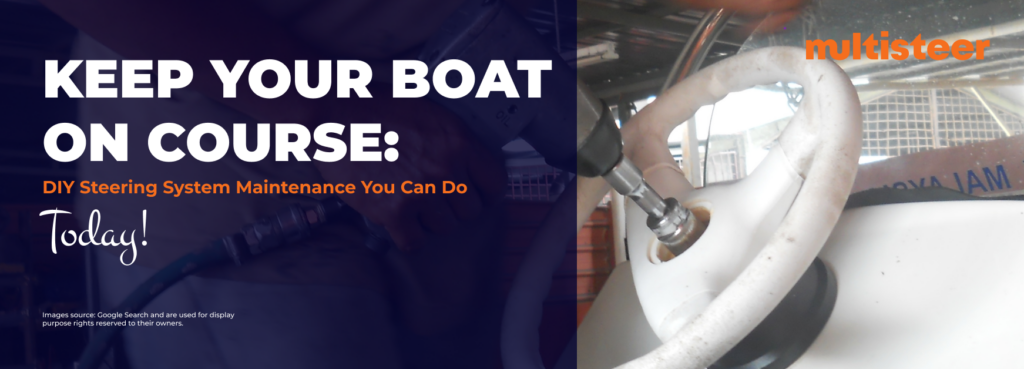Maintaining your boat’s steering system is crucial for safety and performance. Regular maintenance can prevent breakdowns and extend the life of your boat’s components. Here are some important tips to keep your boat’s steering system in good condition with easy DIY maintenance tips. Whether you have a Steerlyte Plus Power-Assisted Steering System or Multisteer Hydraulic Steering System or, you’ll find these tips and step-by-step instructions useful and if followed will ensure your steering is always reliable.
Tools and material you’ll need
Before you begin, check the following necessary tools and materials handy. Having everything on hand will make the process smoother and more efficient. Check the list below:
- Wrenches and a pair of screwdrivers.
- Marine grease and lubricants.
- Replacement parts (Nuts & bolts)
- Cleaning supplies (rags, brushes)
- Protective gear (gloves, safety glasses)
Step-by-step guide to maintaining your boat steering system
Lubricating the system
Proper lubrication is essential for smooth operation. Apply marine grease to the moving parts, including the steering shaft and linkage points. Use lubricants designed for marine environments to protect against saltwater corrosion.
Checking for wear and tear
Examine all components for signs of wear and tear. Pay attention to the steering wheel, helm, and other critical parts. Replace any worn-out parts promptly to keep the system’s integrity. Regular checks can prevent small issues from becoming major problems.
Cleaning and protecting components
Clean the components thoroughly to remove dirt, grime, and salt deposits. Use a mild detergent and water. Apply a protective coating to prevent rust and corrosion. Regular cleaning can extend the life of your steering system.
Replacing worn parts
Over time, certain parts may wear out and need replacement. Keep an eye on components like seals, bushings, and bearings at the Helm and for the cylinders as well. Hoses should be checked for any leaks if hydraulic fluid is discharged very often. Replace these parts as needed to ensure optimal performance. Having spare parts on hand can make the replacement process quicker and easier.
Common boat steering issues and how to fix them
Steering wheel hard to turn
If your steering wheel is hard to turn or is showing latency in response, it could be due to a lack of fluid or leaked hoses. Check and lubricate the system or top-up the hydraulic fluid. You should also go for re-purging if needed. Replace any damaged parts immediately. Regular maintenance can prevent these common issues.
Steering system noises
Unusual noises from the steering system often indicate a problem. Inspect the system for loose components or lack of lubrication. Tighten any loose parts and apply lubricant to reduce noise. Addressing noises early can prevent further damage.
Loose or sloppy steering
Loose or sloppy steering can be dangerous. It usually results from worn-out parts or misalignment. Inspect the system and replace any worn components. Adjust the alignment as necessary to ensure precise steering. Maintaining tight and responsive steering is crucial for safety.
Preventive maintenance tips to keep your boat steering smooth
Preventive maintenance is key to keeping your boat’s steering system in top condition. Regularly check and lubricate the system, inspect for wear and tear, and replace parts as needed. Keep the steering system clean and protected. Following these tips can help you avoid costly repairs and ensure a safe boating experience.
Conclusion: Stay safe and enjoy voyage
By following these DIY maintenance tips, you can keep your boat’s steering system running smoothly and reliably. Regular inspections, lubrication, and part replacements are essential for optimal performance. With a well-maintained steering system, you can enjoy safer and more enjoyable boating adventures. Stay proactive with your maintenance, and your boat will stay on course for many trips to come.
Set Course for Innovation: Discover the Steerlyte Plus Power-Assisted Steering System at METS 2024
Experience the Cutting Edge at METS 2024 The Marine Equipment...
Read MoreWhat Made Multisteer Globally Appreciated: A Closer Look at the Leading Boat Steering System
Boat steering technology is constantly evolving to meet the rigorous...
Read MoreWinterization Tips for Boat Steering Systems
Essential Maintenance and Preparation As winter approaches in various regions,...
Read MoreDon’t panic! The ultimate guide for choosing a hydraulic fluid
Owning a boat is a thrilling experience, but it comes...
Read More




